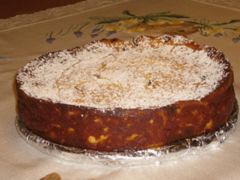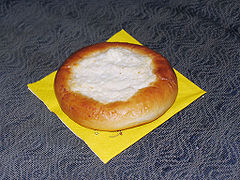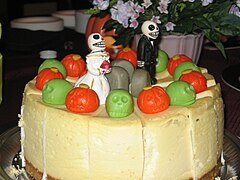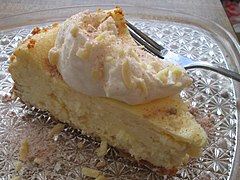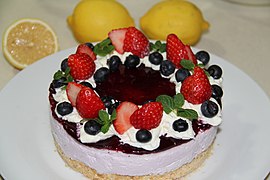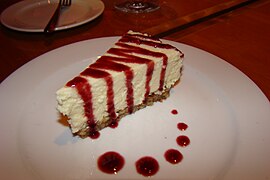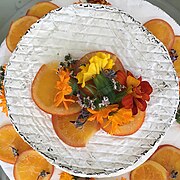Cheesecake
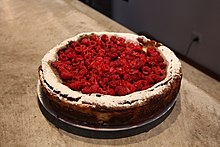 Baked cheesecake with raspberries | |
| Type | Tart |
|---|---|
| Course | Dessert |
| Place of origin | Ancient Greece |
| Main ingredients | Cheese, pie crust (graham cracker crust, pastry, or sponge cake), sugar |
Cheesecake is a sweet dessert consisting of one or more layers. The main, and thickest layer, consists of a mixture of soft, fresh cheese (typically cream cheese or ricotta), eggs, and sugar. If there is a bottom layer, it often consists of a crust or base made from crushed cookies (or digestive biscuits), graham crackers, pastry, or sometimes sponge cake.[1] It may be baked or unbaked (usually refrigerated).
Cheesecake is usually sweetened with sugar and may be flavored in many different ways. It may be flavored by adding vanilla, spices, lemon, chocolate, pumpkin, or other flavors to the cheese layer. Additional flavors and visual appeal may be added by topping the finished pie with fruit, whipped cream, nuts, cookies, fruit sauce, chocolate syrup, or other toppings.
History
An ancient form of cheesecake may have been a popular dish in ancient Greece even prior to Romans' adoption of it with the conquest of Greece.[2] The earliest attested mention of a cheesecake is by the Greek physician Aegimus (5th century BCE), who wrote a book on the art of making cheesecakes (πλακουντοποιικόν σύγγραμμα—plakountopoiikon sungramma).[3] The earliest extant cheesecake recipes are found in Cato the Elder's De Agri Cultura, which includes recipes for three cakes for religious uses: libum, savillum and placenta.[4][5][6] Of the three, placenta is most like most modern cheesecakes, having a crust that is separately prepared and baked.[7]
A more modern version is found in Forme of Cury, an English cookbook from 1390.[8] On this basis, chef Heston Blumenthal has argued that cheesecake is an English invention.[9]
The English name cheesecake has been used only since the 15th century,[10] but the cheesecake did not evolve into its modern form until somewhere around the 18th century. Europeans began removing yeast and adding beaten eggs to the cheesecake instead. With the overpowering yeast flavor gone, the result tasted more like a dessert treat.[11]
Modern commercial American cream cheese was developed in 1872, when William Lawrence, from Chester, New York, while looking for a way to recreate the soft, French cheese Neufchâtel, accidentally came up with a way of making an "unripened cheese" that is heavier and creamier; other dairymen came up with similar creations independently.[12]
Modern cheesecake comes in two different types. Along with the baked cheesecake, some cheesecakes are made with uncooked cream-cheese on a crumbled-biscuit base. This type of cheesecake was invented in the United States.[8]
Classification
Ironically, modern cheesecake is not usually classified as a cake, despite the name. People who classify it as a torte point to the presence of many eggs, which are the sole source of leavening, as a key factor. For others, the overall structure, with the separate crust, the soft filling, and the absence of flour, is compelling evidence that it is a custard pie.[13] Other sources identify it as a flan or tart.[14]
National varieties
Cheesecakes can be broadly categorized into two basic types: baked and unbaked. Each comes in a variety of styles determined by region:
Africa
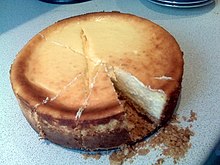
- South Africa
- South Africa has many different varieties of cheesecake. One popular variant is made with whipped cream, cream cheese, gelatine for the filling, and a buttered digestive biscuit crust. It is not baked, and is sometimes made with Amarula liqueur. This variant is very similar to British cheesecake. This cheesecake is more common in British South African communities.[15]
Asia
Asian-style cheesecake flavors include matcha (powdered Japanese green tea), lychee, and mango. Asian-style cheesecakes are also lighter in flavor and are sometimes light and spongy in texture. Compared to its counterparts, Asian cheesecake is also considerably less sweet.

- India
- The Indian state of Odisha is known for chhena poda which is a type of cheesecake made by baking a mixture of chhena - a type of cottage cheese, sugar and nuts.

- Philippines
- The most prominent version of cheesecake in the Philippines is ube cheesecake. It is made with a base of crushed graham crackers and an upper layer of cream cheese and ube halaya (mashed purple yam with milk, sugar, and butter). It can be prepared baked or simply refrigerated. Like other ube desserts in the Philippines, it is characteristically purple in color.[16][17][18]
- Japan
- Japanese-style cheesecake relies upon the emulsification of cornstarch and eggs to make a smooth flan-like texture and almost plasticine appearance.
Australia
Australian cheesecakes are more commonly unbaked.[citation needed] Common flavors include passionfruit, chocolate, raspberry, lemon, caramel, and vanilla.
Europe
- Bulgaria
- Bulgarian-style cheesecake uses cream cheese in a New York–style filling and smetana for a top layer. Ground nuts are often added to the crust mixture.
- France
- French-style cheesecakes are very light, feature gelatin as a binding ingredient, and are typically only 3 to 5 cm (1 to 2 inches) high. This variety gets its light texture and flavor from Neufchâtel cheese.

- Germany
- German-style cheesecake (Käsekuchen, Quarkkuchen, Matzkuchen; Topfenkuchen in Austria) uses quark and a freshly made dough, not Graham crackers. The Käsesahnetorte (cheese cream tart) adds cream and is not baked. This recipe is sometimes translated into English using rennet-based cottage cheese, but a German Quarkkuchen uses quark cheese made from sour milk.
- Greece
- In Greece the cheese cake has been made since antiquity and is now traditionally made using mizithra. There are many regional variants of the mizithropita.
- Italy
- Ancient Roman-style cheesecake uses honey and a ricotta-like cheese along with flour and is traditionally shaped into loaves. Some recipes call for bay leaves, which may have been used as a preservative.[citation needed] Italian-style cheesecake uses ricotta or mascarpone cheese, sugar, vanilla extract, and sometimes barley flakes. This type of cheesecake is typically drier than American styles. Small bits of candied fruit are often added.[citation needed]
- The Netherlands and Belgium
- Dutch/Belgian-style cheesecakes are typically flavored with fruit or melted bittersweet chocolate, are generally made with quark, and are not baked. Belgian cheesecake also includes a speculaas crust (speculaas is a traditional Dutch-Belgian biscuit).

- Poland
- Polish sernik (cheesecake), one of the most popular desserts in Poland, is made primarily using twaróg, Polish quark cheese.
- Portugal
- The Portuguese confectionery Queijada is closely related to cheesecake, although smaller in size and prepared with Requeijão, a typically Portuguese cheese.
- Russia
- Russian-style cheesecake (Vatrushka) is in the form of a dough ring and filled with quark or cottage cheese.[19] The tvorozhnaya zapekanka is a crustless baked cheesecake that mixes tvorog (Russian quark), eggs and semolina, and often includes raisins. It is a traditional snack in Russian kindergartens.

- Sweden
- Swedish-style cheesecake differs greatly from other cheesecakes. A Swedish cheesecake is not layered and is traditionally produced by adding rennet to milk and letting the casein coagulate. It is then baked in an oven and served warm. Since the process of curdling milk is somewhat complicated, alternative recipes intended for home cooking instead use cottage cheese as a base to simulate the texture of the dessert. Swedish-style cheesecake is traditionally served with jam and whipped cream. There are two different types of Swedish cheesecake from different regions in Sweden. To avoid confusion with other cheesecakes, Swedish cheesecake is usually called ostkaka.
- United Kingdom and Ireland
- In the United Kingdom and Ireland, cheesecake is typically made with a base of crushed, buttered biscuits and often topped with a fruit compote. The most common commercial varieties are black cherry, blackcurrant, strawberry, passionfruit, raspberry, and lemon curd. The usual filling is a mixture of cream cheese, sugar, and cream[citation needed] and it is not baked, but refrigerated. Gelatine (sometimes in the form of fruit-flavored dessert jelly[citation needed]) may also be mixed in with the cheese/cream mixture to keep the filling firm. Variations are common, and include banoffee, coffee, tea, chocolate, Irish cream, white chocolate, and marshmallow flavors.[citation needed] Savory smoked salmon cheesecake is made in Scotland.
North America
United States

The United States has several different recipes for cheesecake and this usually depends on the region in which the cake was baked, as well as the cultural background of the person baking it.[20] These cheesecakes are typically baked before serving.
- New York–style cheesecake relies upon heavy cream or sour cream.[21] The typical New York cheesecake is rich and has a dense, smooth, and creamy consistency.[22] Sour cream makes the cheesecake more resilient to freezing and is the method by which most frozen cheesecakes are made. However, a lavish variant uses sour cream as a topping, applied when the cheesecake is cooked. It is mixed with vanilla extract and sugar and replaced in the oven, essentially making the cheesecake twice-baked.
- Chicago–style cheesecake is a baked cream-cheese version which is firm on the outside with a soft and creamy texture on the inside. These cheesecakes are often made in a greased cake pan and are relatively fluffy in texture. The crust used with this style of cheesecake is most commonly made from shortbread which is crushed and mixed with sugar and butter. Some frozen cheesecakes are Chicago-style.[23]
Gallery
-
Bavarian baked cheesecake
-
Romanian cheesecake
-
Russian cheesecake (Vatrushka)
-
Making a cheesecake
-
Halloween Cheesecake
-
"No bake" cheesecake with orange jelly
-
German cheese cake
-
New York-style cheesecake with strawberry
-
Cheesecake with cream
-
Blueberry and mixed fruit cheese cake
-
Strawberry cheese cake
-
A slice of goat cheesecake
-
Cheesecake with mango
-
Cheesecake with orange slices
-
Lemon Cheesecake
-
Cheesecake pancakes
-
Japanese no-bake cheesecake with strawberry source
See also
References
- ^ Ferguson Plarre Bakehouses. "A History of Cheesecakes". www.fergusonplarre.com.au. Retrieved 2008-10-12.
- ^ Dana Bovbjerg, Jeremy Iggers, The Joy of Cheesecake, Barron's Educational Series, 1989
- ^ Callimachus, ap. Athen, xiv. p. 643, e
- ^ Cato the Elder, De Agri Cultura, paragraphs 75 and 76. Available in English on-line at: University of Chicago: Penelope (Note: The "leaves" mentioned in Cato's recipe are bay leaves.)
- ^ "Cato's 'De Agricultura': Recipes". www.novaroma.org. Retrieved 2008-10-12.
- ^ "Cato's 'De Agricultura': Recipes".
- ^ "A Bit of Food History: Cheesecake" (PDF). www.culinaryschools.com. Retrieved 2008-10-12.
- ^ a b Wilson, C. (2002). "Cheesecakes, Junkets, and Syllabubs". Gastronomica. 2 (4): 19. doi:10.1525/gfc.2002.2.4.19.
- ^ Heston Blumenthal (2013). Historic Heston. Bloomsbury. p. 35. ISBN 978-1-4088-0441-4.
- ^ John., Ayto, (2002). An A-Z of food and drink. Ayto, John. Oxford: Oxford University Press. ISBN 0192803522. OCLC 48932542.
{{cite book}}: CS1 maint: extra punctuation (link) CS1 maint: multiple names: authors list (link) - ^ "The Rich History of a Favorite Dessert". Cheesecake.com. Retrieved 2019-01-09.
- ^ cheesecake History
- ^ Berenbaum, Rose Levy (1988). The Cake Bible. William Morrow Cookbooks. ISBN 978-0-688-04402-2. p. 80.
- ^ Bender, David A. (2014-01-23). A Dictionary of Food and Nutrition. Oxford University Press. ISBN 9780192518422.
cheesecake: A flan or tart filled with curd or cream cheese.
- ^ "A South African Favourite: Amarula Cheesecake". The International Hotel School. The International Hotel School. August 2014. Archived from the original on 2015-02-12. Retrieved 2015-01-01.
- ^ "Ube Cheesecake". The Peach Kitchen. Retrieved 7 July 2019.
- ^ "Creamy and Luscious Ube Cheesecake". Woman Scribbles. Retrieved 7 July 2019.
- ^ "Ube Cheesecake with Coconut Cookie Crust and Coconut Whipped Cream (Video)". The Unlikely Baker. Retrieved 7 July 2019.
- ^ "Russian Oven: King's Vatrushka, a Russian-style cheesecake - Russia Beyond". Rbth.com. 2015-11-26. Retrieved 2019-01-09.
- ^ Mitchell, Russ (21 November 2010). "Say Cheesecake!". CBS News. Retrieved 17 December 2010.
- ^ "Towards A Unified Theory of the New York Cheesecake".
- ^ NY Cheese Cake Recipe & Video – Joyofbaking.com *Video Recipe*
- ^ Krause, Andrew (2006). "Different Types of Cheesecake".

